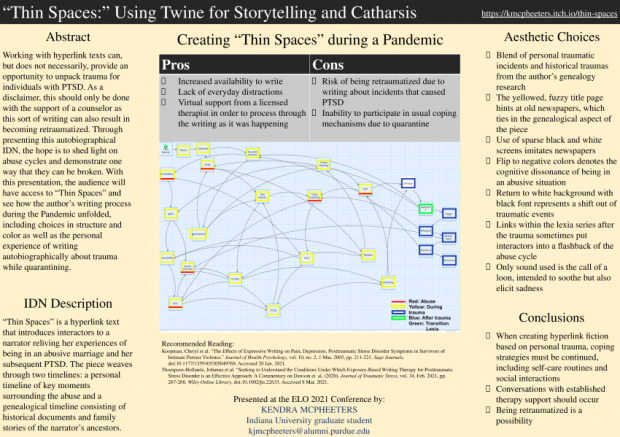"Thin Spaces:" Using Twine for Storytelling and Catharsis
For individuals who have suffered from abuse, working with hyperlink texts can, but does not necessarily, provide an opportunity to unpack trauma and experience catharsis. As a disclaimer, this should only be done with the support of a counselor as this sort of writing can also result in becoming retraumatized. “Thin Spaces” is a hyperlink text that introduces interactors to a narrator reliving her experiences of being in an abusive marriage and her subsequent PTSD. Through presenting this autobiographical IDN, the hope is to shed light on abuse cycles and demonstrate one way that they can be broken. “Thin Spaces” weaves through two timelines: a personal timeline of key moments surrounding the abuse and a genealogical timeline consisting of historical documents and family stories of the narrator’s ancestors. The blending of personal experience and genealogy shows that abuse can span generations. The initial framework of the story forms a cycle that culminates in a therapy session. This lexia’s single hyperlink takes readers back to an earlier lexia in the story. This earlier lexia maintains its initial hyperlinks but introduces a new option to break the cycle using an italicized sentence offset from the rest of the text. The strand of lexia proceeding from this new hyperlink moves interactors through the aftermath of the narrator’s divorce, culminating in the hope that survival is possible. Like PTSD, some options in the new lexia–with inverse colors from the initial cycle–cause the reader to re-experience the traumatic episodes of the piece and require them to make the conscious decision to either hit the previous screen arrow within Twine to exit that phase quickly or work through the abusive sections again to find their way back out of the abuse. Being given this choice ties to the aftermath of trauma in which some PTSD episodes can be resolved quickly through deep breathing, self-talk, or somatic strategies while other episodes resist these tactics and take longer to escape. The interactor must be cognizant of the strategy of clicking the previous screen arrow in order to avoid lapsing back into a more lengthy process of sifting through abusive flashbacks, which parallels abuse survivors needing to have the wherewithal to employ the strategies they learn in order to avoid more serious flashbacks or PTSD episodes. At its conclusion, “Thin Spaces” shifts to the narrator being in a healthier place, though still using coping mechanisms to deal with the effects of the trauma. The piece allows readers the choice to exit with the call of the common loon, a calming sound to soothe the interactor after this experience. With this presentation, the audience will have access to “Thin Spaces” and see how the author’s writing process during the Pandemic unfolded, including choices in structure and color as well as the personal experience of writing autobiographically about trauma while quarantining.


